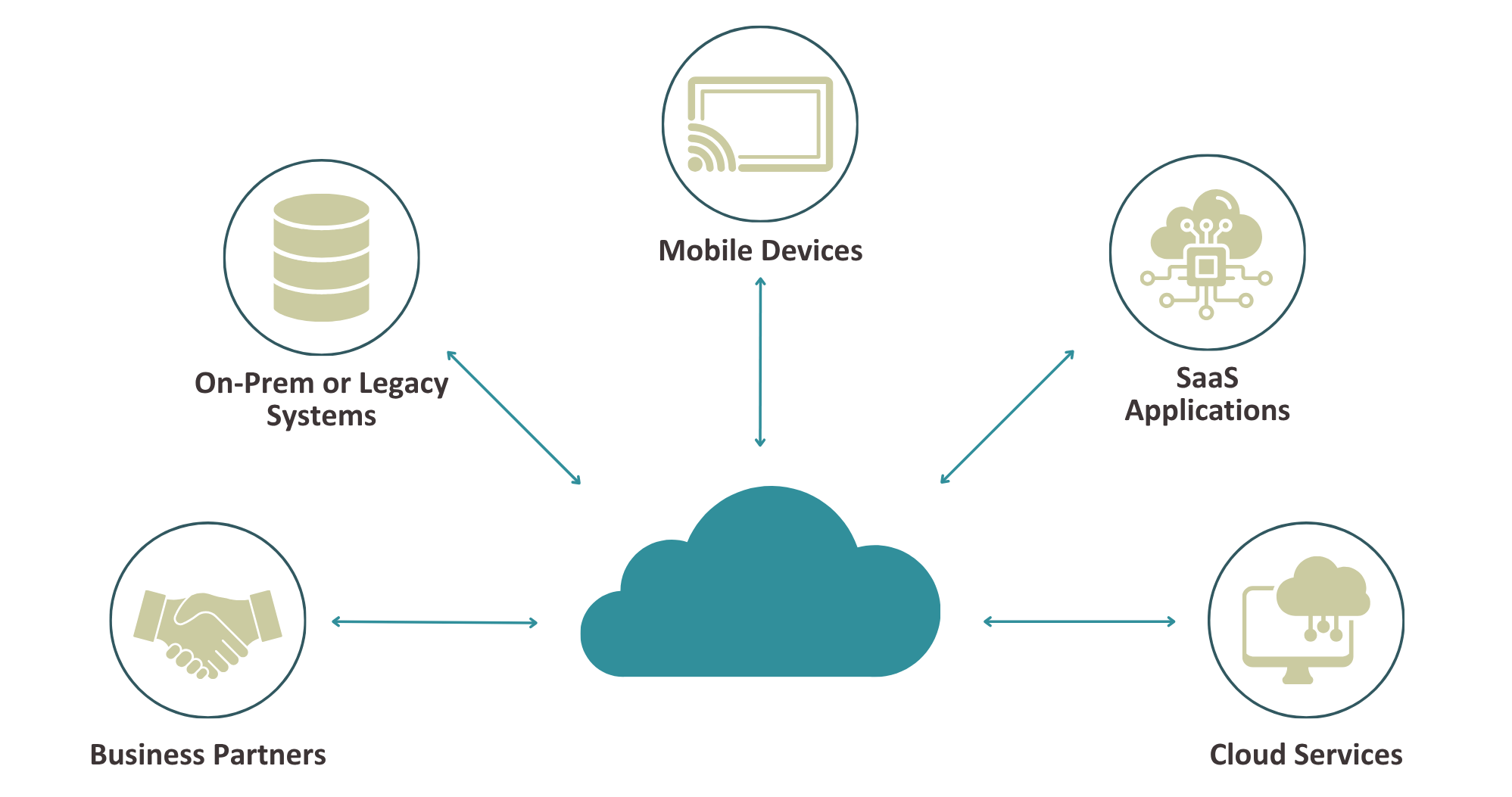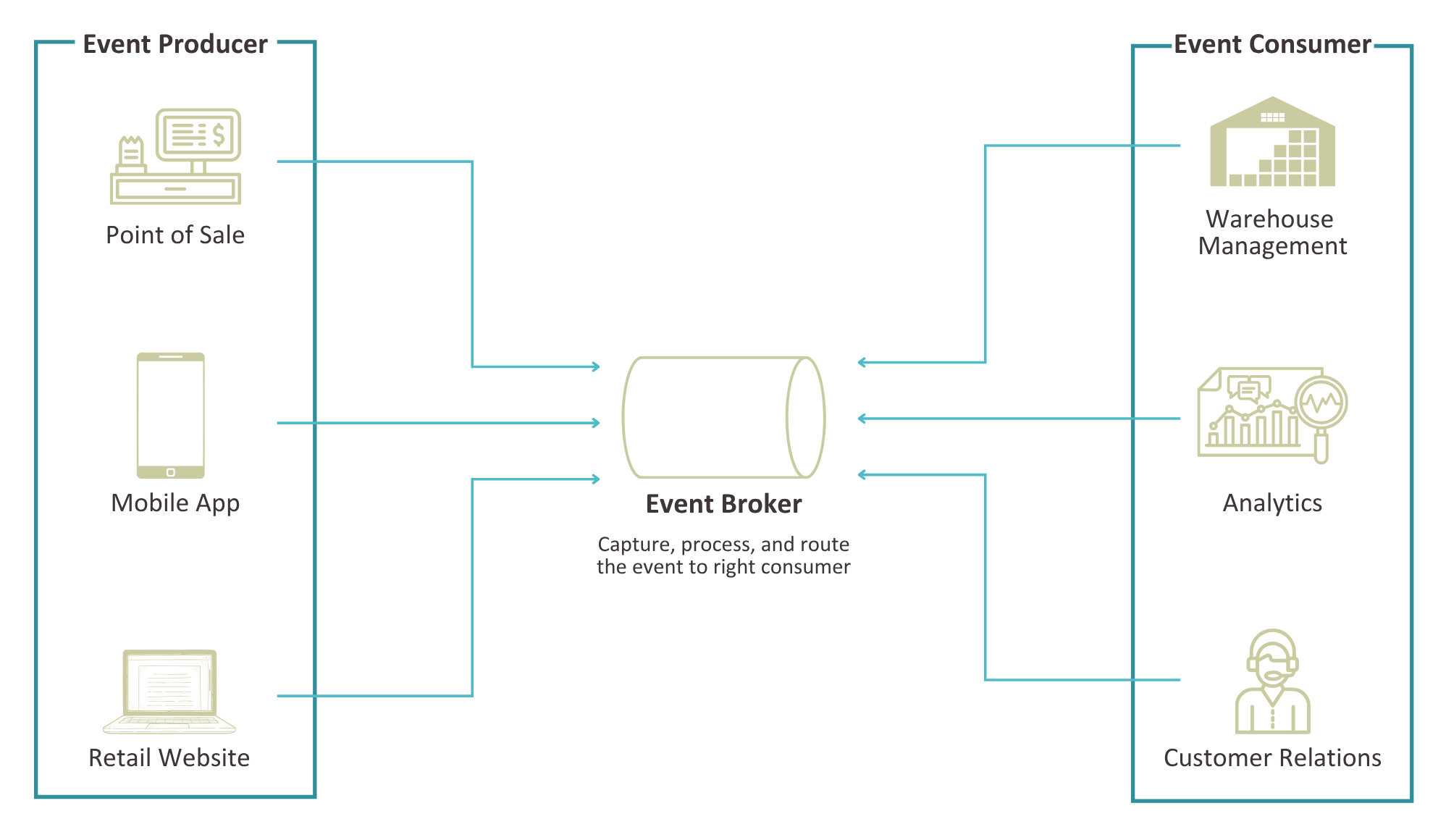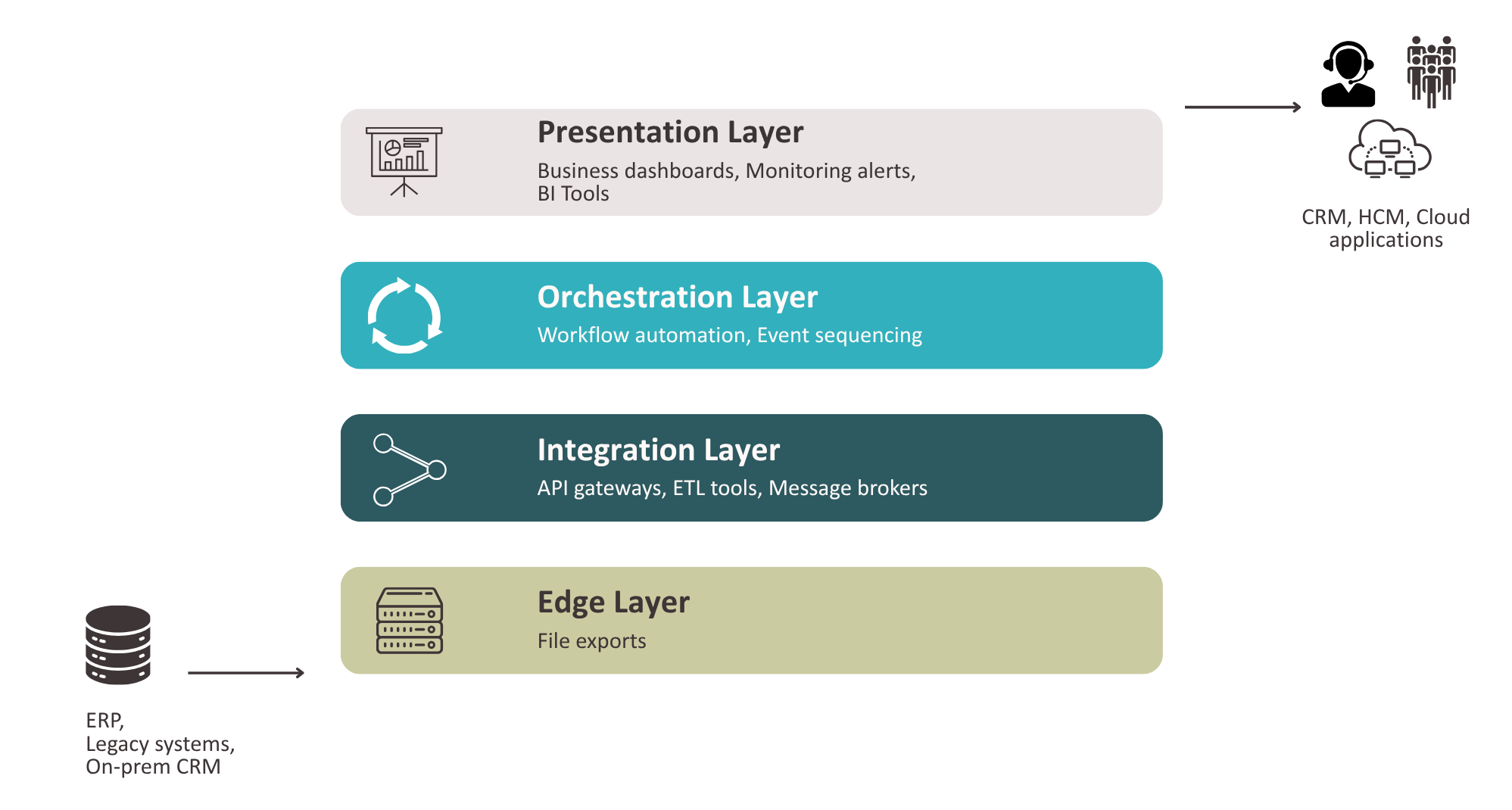Digital Transformation is fundamentally about enabling agility, innovation, and resilience through rethinking of business models and processes – powered by technology. In pursuing this agenda, organizations are increasingly shifting from traditional, on-premise infrastructure and applications to cloud-based platforms and services. Cloud plays a pivotal role because it offers scalability, speed of deployment, commercial flexibility, and access to innovation at scale – capabilities difficult to achieve in static, on-prem environments. Yet, this shift is not binary or instantaneous. Regulatory constraints, legacy investments, and operational realities often require organizations to operate in hybrid IT environments, where cloud-native, SaaS, and on-premise systems coexist, sometimes for years.
These hybrid environments bring strategic opportunity, but also architectural complexity, especially in how systems are integrated, data is exchanged, and services are orchestrated. Without intentional integration strategy and governance, organizations risk creating fragile, fragmented IT landscapes that undermine the very agility digital transformation aims to unlock.
This article presents a structured point of view on how to manage integrations in a hybrid IT landscape, offering practical insights for CIOs, Enterprise Architects, and IT leaders. Drawing from real-world experiences and proven architectural patterns such as iPaaS, event-driven architecture (EDA), and layered integration, we explore why hybrid integration demands deliberate strategy, governance, and architectural planning.
Hybrid IT is not a design choice – It’s an evolutionary reality
Hybrid IT landscapes rarely result from greenfield architectural planning. They emerge organically driven by cloud adoption, SaaS implementation, M&A activities, or constraints like regulatory compliance and legacy system dependencies. Though often considered a transitional state, hybrid IT landscapes can persist for years, sometimes indefinitely. As such, integration is not just a technical afterthought – it becomes a strategic competency.
A hybrid IT landscape is not a final state, but an evolving one and managing integrations within it requires thoughtful architectural planning, not just tactical improvisation.
Where Hybrid Integrations Hurt the Most
While hybrid IT landscapes offer flexibility and continuity, they also introduce a new category of integration pain points that extend beyond technology into architecture, security, and operations. Common issues include:
- Mismatched Lifecycles: On-prem systems typically follow multiyear upgrade cycles, while SaaS platforms evolve rapidly and continuously creating friction in change management and version compatibility
- Limited Extensibility (in both directions): Modern SaaS solutions often expose only a narrow set of APIs, while legacy systems may offer none at all. This frequently necessitates workarounds such as file-based transfers or integration middleware
- Fragmented Identity Management: Hybrid environments often rely on multiple identity sources (e.g., Active Directory on-prem and OAuth in the cloud), leading to inconsistent provisioning and governance gaps
- Manual Interventions: In low-maturity integrations, operations or business teams are often forced to manually close integration loops such as correcting data mismatches, reprocessing failures, or initiating syncs across disconnected systems
- Increased Operational Overhead: Maintaining hybrid integrations often requires custom scripts, tailored middleware logic, and exception handling for batch jobs, file interfaces, and real-time APIs resulting in significant effort from IT and support teams
- Security & Compliance Risks: Many so-called SaaS solutions are “lift-and-shift” versions of legacy applications and may lack modern security controls such as federated user provisioning, multi-tenant access governance, or support for external integration endpoints. This exposes organizations to compliance risks, especially in regulated industries
In essence, hybrid integrations create an environment where technical diversity must be matched with architectural discipline, without which agility and scale remain out of reach.
Architectural Patterns to Tame Hybrid Complexity
The antidote to this hybrid complexity lies not in technology or tools alone, but in adopting robust, modular architectural models that provide clarity, scalability, and long-term control.
- iPaaS (Integration Platform as a Service) is a cloud-based middleware providing abstraction, central management, and connectors to various systems. Platforms like Microsoft Azure Logic Apps, SAP integration suite or Anypoint (by MuleSoft) centralize integrations with pre-built connectors, monitoring and low-code configuration. They are ideal for organizations with diverse, fast-changing integration needsThink of iPaaS as an airport hub with gates pre-assigned to your applications.

- Event-Driven Architecture (EDA) embraces real-time data exchange via events and helps decouple systems to support scalability. Instead of tightly linking systems through request-response (like traditional APIs), systems are loosely coupled. This enables new consumers to consume data without changing existing integrations and allows data to flow in real time. Use cases for EDA can include order processing, inventory updates. For instance:
When a Sales Order is confirmed in an ERP system, an event broker, typically a middleware, publishes an Order confirmed event.
-
- The Warehouse Management System (WMS) consumes the event to trigger picking and packing
- The CRM system consumes the same event to update the customer record with order status
- The Analytics/BI platform listens to the event stream to update dashboards in near real time

- Layered Integration Model:
This pattern separates integration responsibilities across architectural layers – from data extraction to orchestration to monitoring. Think of it as a supply chain with specialized departments (picking, packing, shipping, tracking), each layer handles one part of the process. For instance:- Edge Layer: Adapters for source systems (e.g., file exports)
- Integration Layer: API gateways, ETL tools, message brokers
- Orchestration Layer: Workflow automation, event sequencing (e.g., Azure Logic Apps)
- Presentation Layer: Dashboards and alerts for monitoring

In many hybrid IT environments, integrated data from ERP, CRM, and SaaS platforms is funnelled through the integration layer into a data lake, where it is harmonized and stored for analytical and operational use.
These architectural patterns and approaches illustrate just how varied integration strategies can be across enterprises. What works in one context may fail in another. There is no universally “best” integration model but only a fit-for-purpose one. The right choice depends on the context and architecture must reflect the system maturity, business need, and operational capabilities of the organization.
Choosing the right architecture for the right context –

With extensive experience across hybrid integration scenarios, Opticos helps organizations cut through complexity and design platform-agnostic, fit-for-purpose architectures that balance today’s needs with tomorrow’s scalability.
Beyond selecting the fit-for-purpose integration approach, effective governance remains a key component of hybrid IT success. It ensures that integration efforts stay aligned with enterprise priorities, maintain consistency, and evolve sustainably over time.
Govern the Interim to Enable the Future
Hybrid states are often intended to be temporary but without clear governance, they risk becoming long-term liabilities. A strong governance model can turn hybrid integration from a risk to a roadmap. Core principles include:
- Define ownership and roles across IT and business, especially for integration support, lifecycle management, and exception handling
- Prioritize automation over manual processes, leveraging APIs and event-driven architectures to reduce human intervention and improve efficiency
- Implement integration KPIs such as percentage of real-time vs. batch jobs, number of manual interventions, and time-to-resolution for integration issues
- Design for sunsetting: Treat every interim solution (e.g., file transfers, middleware bridges) as a temporary measure with a clear decommissioning plan
Governance is what can transform hybrid integration from a reactive burden into a forward-looking capability. Without it, organizations risk falling into the trap of permanent interim solutions. In short, governance provides the guardrails that keep hybrid integration aligned with enterprise strategy, rather than drifting into fragmented, ad-hoc solutions.
Final Word: From Tactical Patching to Strategic Design
Hybrid IT is not going away anytime soon. But its limitation, and the complexity it introduces, can be addressed through intentional architecture, measured governance, and organizational readiness.
Throughout this article, we have outlined how CIOs, IT leaders, and Enterprise Architects can transition from short-term fixes to long-term integration capability. But that transformation requires discipline.
Here’s what leadership should prioritize:
- Design Hybrid Consciously: Do not let integrations emerge by accident. Define integration principles early to avoid architectural sprawl
- Automate Where Possible: APIs and event-driven models should be the default. Where APIs are unavailable, Robotic Process Automation (RPA) can serve as an interim tactic but should not become a permanent strategy
- Build for Extensibility: Use tools and integration patterns that can evolve as systems mature. Avoid hardcoding today’s constraints into tomorrow’s infrastructure
- Support the “Long Tail”: Even low-volume, temporary, or one-off flows need design and monitoring. They often cause the highest operational overhead when neglected
- Centralize Monitoring and Ownership: Create visibility across all integration layers – batch jobs, events, middleware – and assign clear operational responsibility
- Promote Reusability: Standardize integration assets (e.g., reusable connectors, orchestration logic) across programs to reduce duplication and accelerate delivery
- Think End-to-End: Integration is not only about moving data. Consider security, access management, governance, and lifecycle alignment from day one
Hybrid integration is no longer just an IT concern but a strategic enabler of digital transformation. The destination is not just technical connectivity, but a state where your architecture is adaptive, your operations are efficient, and your teams are empowered. That shift from patching to planning can be achieved with conscious design to build a foundation for scalable, secure, and resilient enterprise systems.
About Opticos: Opticos is a management consultancy firm specializing in digital transformation, enterprise architecture, and IT strategy. Our consultants support global clients in navigating complex transitions, managing hybrid landscapes, and building future-proof IT ecosystems.
Contact us to learn more
Sources
- Gartner (2023). “How to Architect for Hybrid Integration Platforms.”
- Everest Group (2022). “iPaaS in the Enterprise Landscape.”
- McKinsey & Co (2023). “The CIO Agenda for a Digital-First World.”

